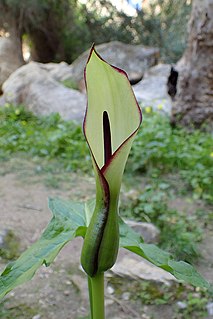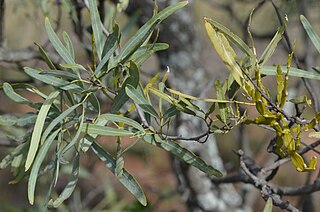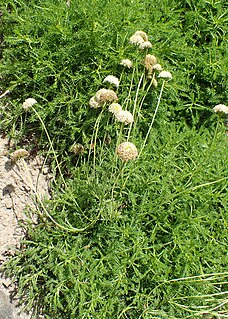
Royal Botanic Gardens, Kew is a non-departmental public body in the United Kingdom sponsored by the Department for Environment, Food and Rural Affairs. An internationally important botanical research and education institution, it employs 1,100 staff. Its board of trustees is chaired by Dame Amelia Fawcett.

Ulmus castaneifoliaHemsley, the chestnut-leafed elm or multinerved elm, is a small deciduous tree found across much of China in broadleaved forests at elevations of 500–1,600 metres (1,600–5,200 ft).

Symphyotrichum ericoides, known as white heath aster, frost aster, or heath aster, is a species of flowering plant in the family Asteraceae native to much of central and eastern North America. It has been introduced to parts of Europe and western Asia.

Pluchea obovata is a species of flowering plant in the family Asteraceae. It is endemic to Yemen. Its natural habitat is rocky areas.

Pulicaria aromatica is a species of flowering plant in the family Asteraceae. It is found only in Yemen. Its natural habitats are subtropical or tropical dry forests and rocky areas.

Vernonia cockburniana is a species of flowering plant in the Asteraceae family. It is endemic to Yemen. Its natural habitats are subtropical or tropical dry forests and subtropical or tropical dry shrubland.

The genus Cousinia of the tribe Cardueae is in its current circumscription one of the larger genera in the Asteraceae, with approximately 650-700 species distributed in central and western Asia.
Planchonella pinifolia is a species of plant in the family Sapotaceae. It is endemic to New Caledonia.

Artemisia campestris is a common and widespread species of plants in the sunflower family, Asteraceae. It is native to a wide region of Eurasia and North America. Common names include field wormwood, beach wormwood, northern wormwood, Breckland wormwood, boreal wormwood, Canadian wormwood, field sagewort and field mugwort.

Chrysocephalum semipapposum, commonly known as clustered everlasting is a perennial shrub native to Australia. Clustered everlasting belongs to the family Asteraceae. C. semipapposum produces terminal flowers heads in clusters, mainly between spring and early summer with silver-grey appearing stems and branches. It grows up to 40cm high and 60 cm high, although there have been some varieties which can grow up to 1 m. C. semipapposum is often confused with Chrysocephalum apiculatum or 'yellow buttons', due to their similar appearances. C. semipapposum has 4 different subspecies, however they lack distinctive qualities and are often hard to identify. C. semipapposum is endemic to Australia and can be found in multiple states, most notably within Victoria. The plant is found in a variety of habitats including dry rocky regions. Clustered everlasting often grows sparsely and is rarely found in abundance and can be mistaken for a weed. Clustered everlasting has many uses, including as a source of nectar for butterflies, cut flowers or as an addition to a garden.
Oreoseris is a genus of flowering plants in the family Asteraceae, native to Anatolia, Central Asia, the Himalaya region, and Thailand. Originally described in 1838, it was resurrected with the Asian species of Gerbera and all the species of Uechtritzia in 2018.

Arum hygrophilum is a species of flowering plant in the family Araceae. It has a disjunct distribution, found in Israel, Jordan, Lebanon, Syria, Cyprus and Morocco.

Symphyotrichum subulatum, commonly known as eastern annual saltmarsh aster or, in Britain and Ireland where it is naturalized, annual saltmarsh aster, is an annual plant in the family Asteraceae native to the eastern United States and the Gulf Coast to Texas. The species grows primarily in coastal salt marshes, although in the Ozarks it occurs as a non-marine weedy variety.

Korthalsella rubra is a flowering plant in the Santalaceae (sandalwood) family, formerly placed in the Viscaceae.
Yvonne Chuan Fang Su is a Hong Kong evolutionary biologist who is notable for her co-discovery of Pseuduvaria bruneiensis and Pseuduvaria borneensis. Her doctoral work at the University of Hong Kong focused on the phylogeny of the flowering plant genus Pseuduvaria. Her work as a faculty member at Duke–NUS Medical School focuses on the evolution of viruses.
Jailoloa is a genus of palm, in the subtribe Ptychospermatinae. It has only one currently accepted species, Jailoloa halmaherensis, native to the Moluccas. It only grows on ultramafic soils. The species is currently known only from its type locality in East Halmahera.
Achyranthemum, commonly called the chaff flowers, is a genus of flowering plant in the family Asteraceae which is native to South Africa. The genus was first described by Nicola Bergh in 2019 in the South African Journal of Botany, and it was segregated from the genus Syncarpha due to its representation of a separate lineage.

Santolina pinnata, called lavender cotton along with other members of its genus, is a species of flowering plant in the family Asteraceae, native to northwest Italy. Its putative subspecies Santolina pinnata subsp. neapolitana, the rosemary-leaved lavender cotton, has gained the Royal Horticultural Society's Award of Garden Merit.

Dimorphotheca jucunda, the delightful African daisy, is a species of flowering plant in the family Asteraceae. It is native to South Africa, Lesotho and Eswatini, and introduced to Ireland and Tasmania. As its synonym Osteospermum jucundum, it and two of its cultivars, 'Blackthorn Seedling' and 'Langtrees' have gained the Royal Horticultural Society's Award of Garden Merit.

Peperomia serpens, the vining peperomia, is a species of flowering plant in the genus Peperomia and family Piperaceae, native to the New World Tropics. The plant is perennial.















